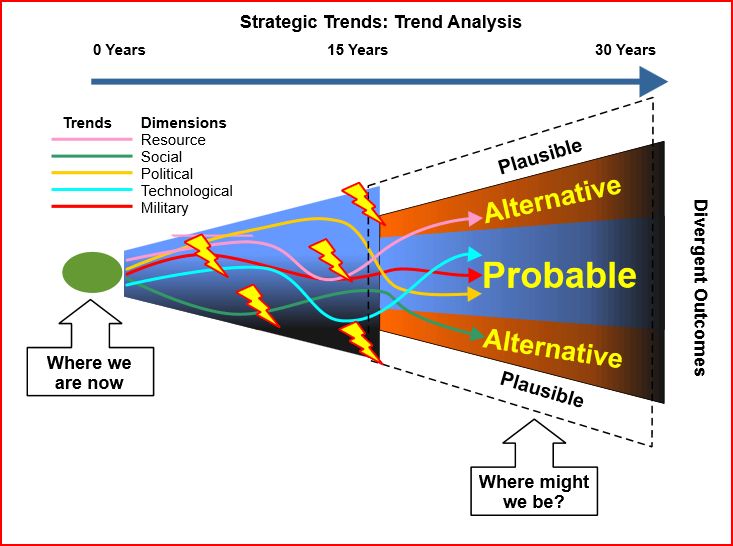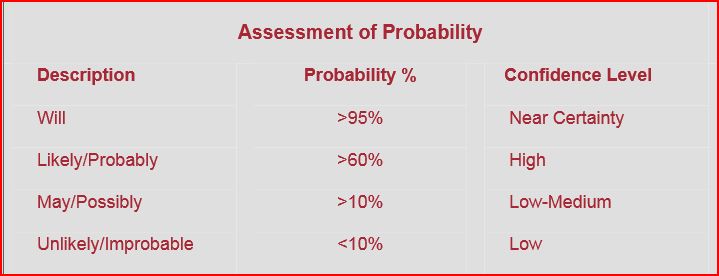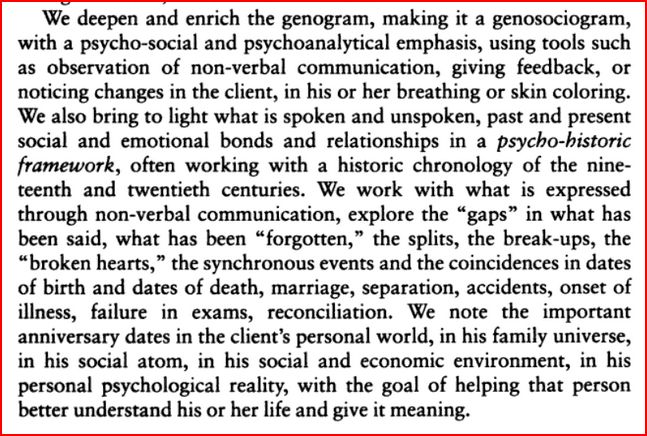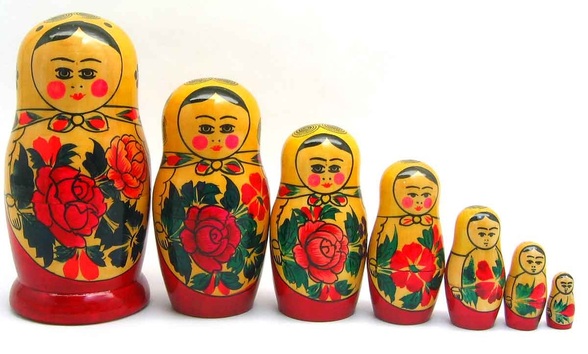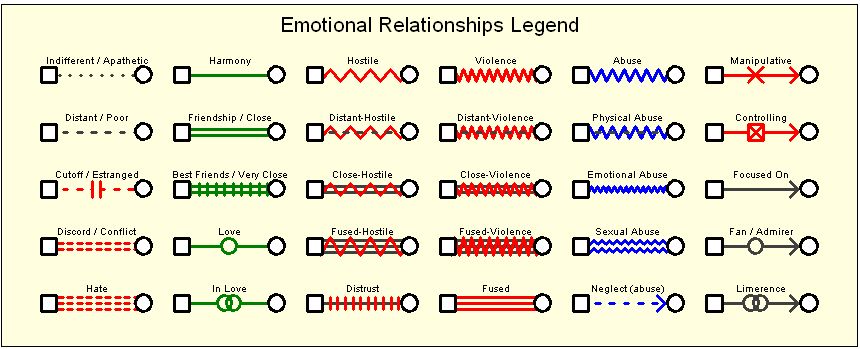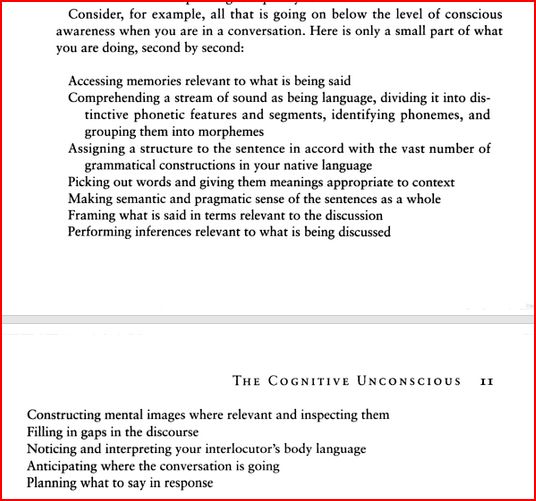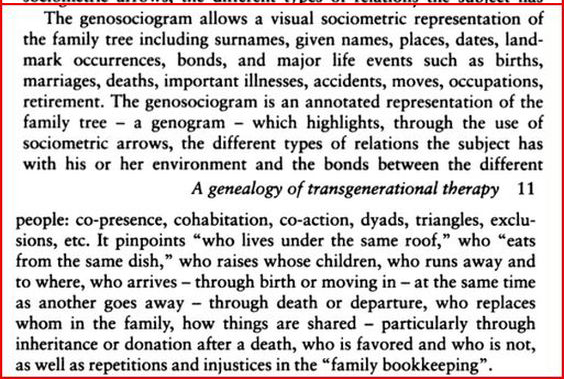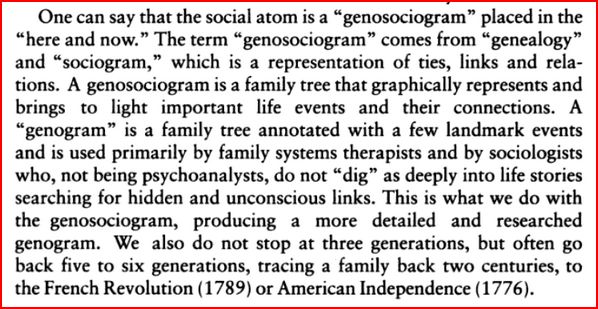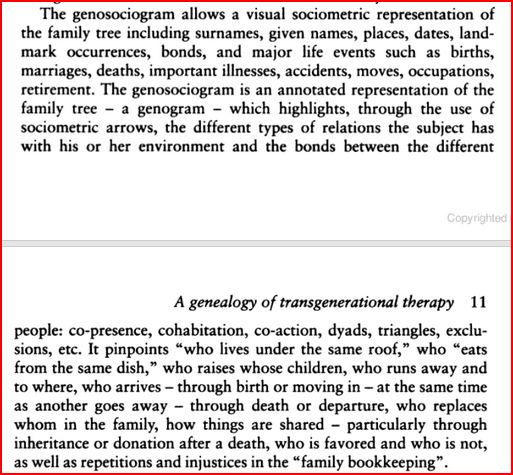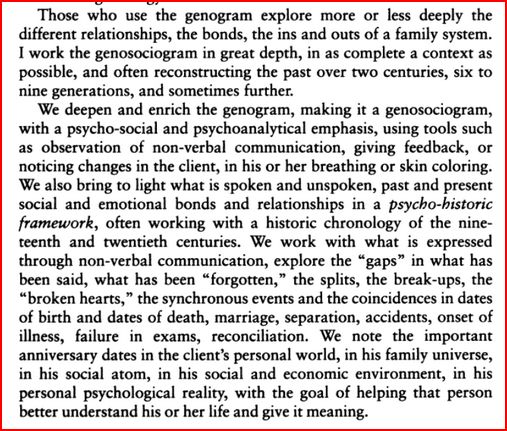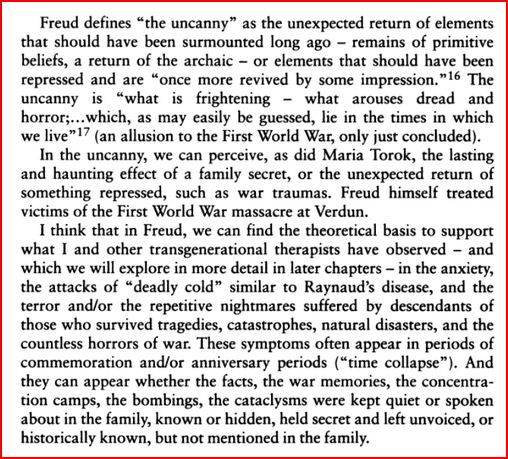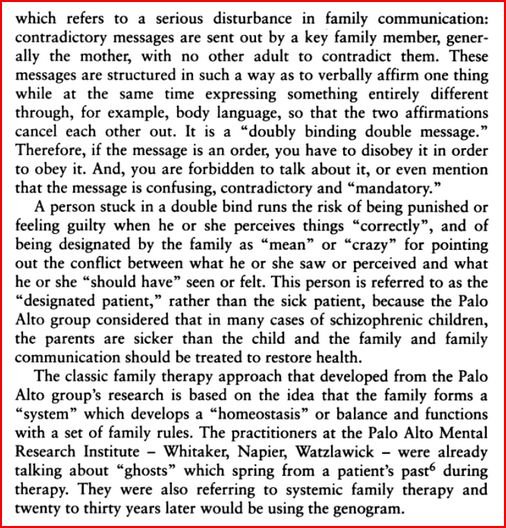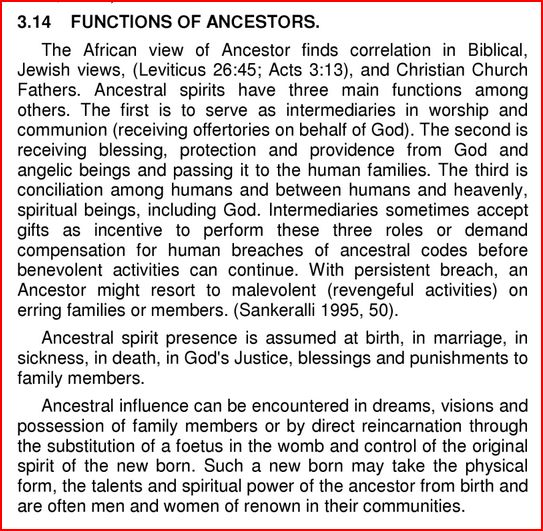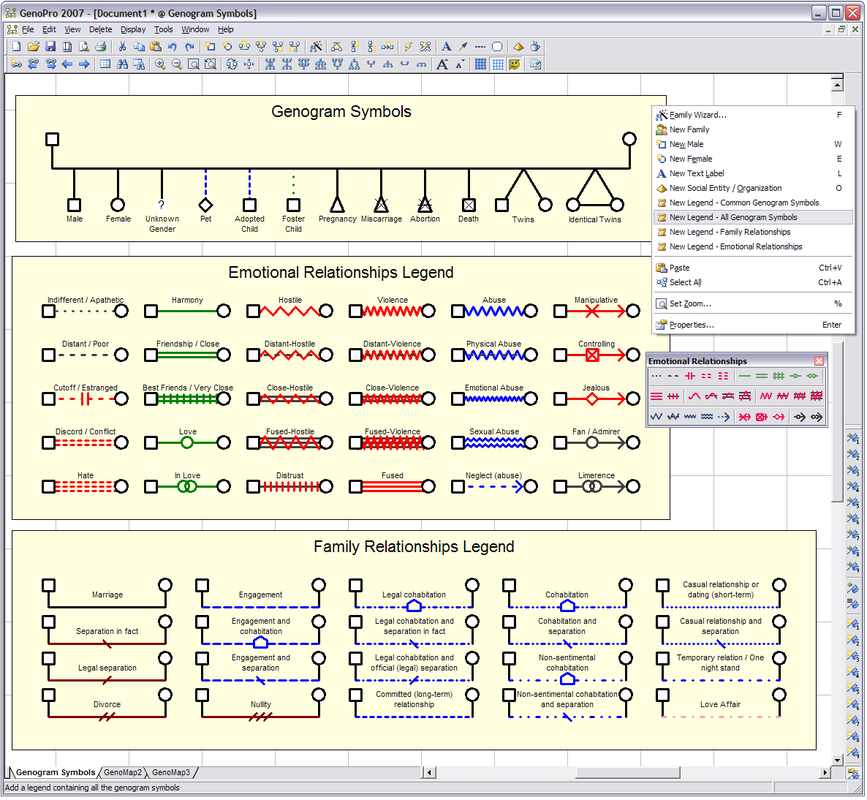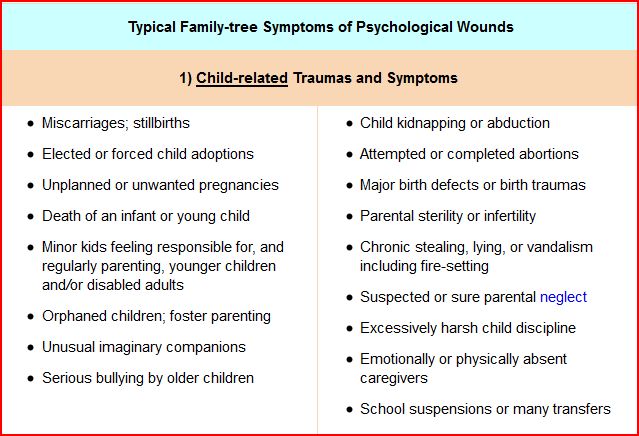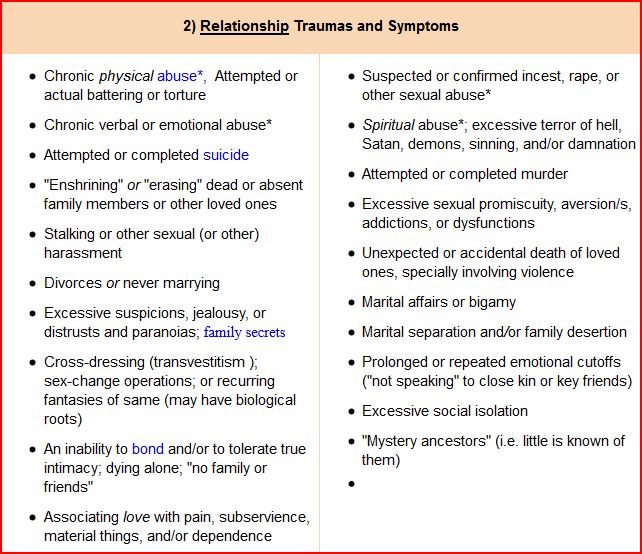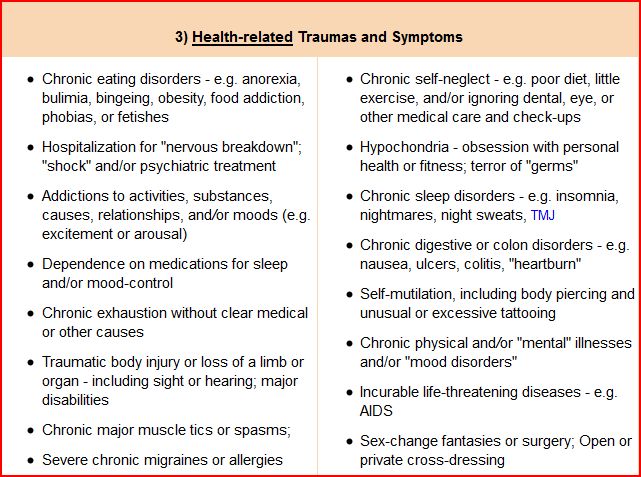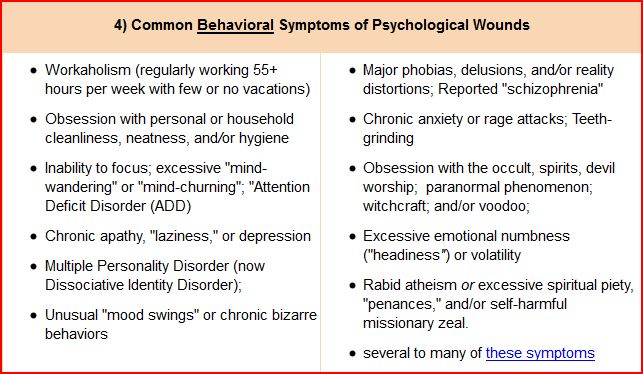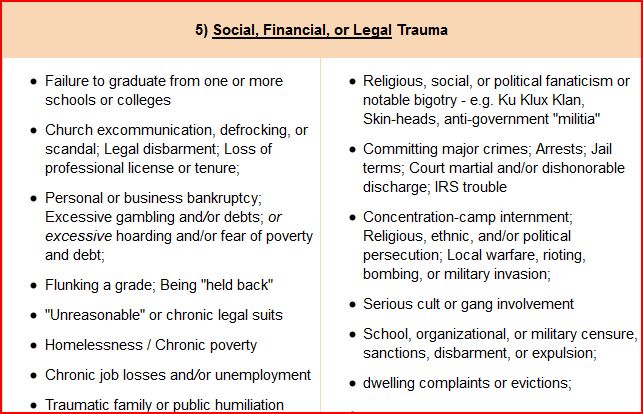GENOGRAM
EMOTIONAL GENEALOGY
Transgenerational Patterns
Embodied Mind
https://www.psychologytoday.com/blog/life-is-trip/201401/what-is-your-emotional-genealogy
EMOTIONAL GENEALOGY
Transgenerational Patterns
Embodied Mind
https://www.psychologytoday.com/blog/life-is-trip/201401/what-is-your-emotional-genealogy
The Ancestor Effect
HARMONICES MUNDI – JOHANNES KEPLER (1619)
"The soul of the newly born baby is marked for life by the pattern of the stars at the moment it comes into the world, unconsciously remembers it, and remains sensitive to the return of configurations of a similar kind." Johannes Kepler, Harmonices Mundi, chapter 7 (1619 first edition
A genogram is a Family Diagram[2]) a pictorial display of a person's family relationships and medical history. It goes beyond a traditional family tree by allowing the user to visualize hereditary patterns and psychological factors that punctuate relationships.[1] It can be used to identify repetitive patterns of behavior and to recognize hereditary tendencies.[3]
Genograms were first developed and popularized in clinical settings by Monica McGoldrick and Randy Gerson through the publication of a book titled Genograms: Assessment and Intervention in 1985. Genograms are now used by various groups of people in a variety of fields such as medicine, psychiatry, psychology, social work, genetic research, education, and many more. Some practitioners in personal and family therapy use genograms for personal records and/ or to explain family dynamics to the client. Few if any genealogists use them.[4] https://en.wikipedia.org/wiki/Genogram
HARMONICES MUNDI – JOHANNES KEPLER (1619)
"The soul of the newly born baby is marked for life by the pattern of the stars at the moment it comes into the world, unconsciously remembers it, and remains sensitive to the return of configurations of a similar kind." Johannes Kepler, Harmonices Mundi, chapter 7 (1619 first edition
A genogram is a Family Diagram[2]) a pictorial display of a person's family relationships and medical history. It goes beyond a traditional family tree by allowing the user to visualize hereditary patterns and psychological factors that punctuate relationships.[1] It can be used to identify repetitive patterns of behavior and to recognize hereditary tendencies.[3]
Genograms were first developed and popularized in clinical settings by Monica McGoldrick and Randy Gerson through the publication of a book titled Genograms: Assessment and Intervention in 1985. Genograms are now used by various groups of people in a variety of fields such as medicine, psychiatry, psychology, social work, genetic research, education, and many more. Some practitioners in personal and family therapy use genograms for personal records and/ or to explain family dynamics to the client. Few if any genealogists use them.[4] https://en.wikipedia.org/wiki/Genogram
INTERGENERATIONAL TRAUMA
Therapy As Ritual & Ritual As Therapy
Therapy As Ritual & Ritual As Therapy
The Nature of Life After Trauma
Recently, epigenetics has been identified as a vector for the intergenerational transmission of the effects of trauma. Such issues can be addressed in the therapeutic context and creative rituals can be devised to moderate symptoms in conjunction with a variety of treatments. Trauma can be associated with intergenerational psychobiological developments. Jung considered ritual, (including contact with nature and creativity, movement, music, drama, myth), as a means of transformation and rebirth. Therapy is a sacred temenos where the ritual of therapy -- a ritual of healing -- takes place.
Historical Traumas
Historical trauma includes personal or collective cumulative physical, emotional, psychological, and even spiritual wounding, exceeding over an individual lifespan and across generations, caused by significant personal or group traumatic experiences, including war, famine, rape, incomplete grieving for lost children and family, mental and physical illness of caregivers or significant others, servitude or slavery, deprivation, poverty, and more.
Symptoms and stressors range from abandonment, attachment disorder, violence and substance abuse to self-destructive behavior, suicidal thoughts and gestures, depression, anxiety, low self-esteem, anger, and difficulty recognizing and expressing emotions. Corresponding mental, physical and emotional disturbances can be experienced by a descendant.
Conceivably effects from family systems might be experienced despite the fact that you have no knowledge of, and have never met, that person. This remains valid even if that person is long dead, and might include behaviors, trait expression, neurochemistry, immune function, fear response, secondary emotions and mannerisms.
Treatment centers around exploring self-knowledge, repair of connections with others, self-image, values and beliefs. Focus is on family systems and ancestral networks. It takes the forms of individual counseling or therapy, spiritual help, and group or entire community gatherings, important to the healing process. It aims at renewal of hope, positive self-image and spiritual beliefs, renewal of family connections, and reaffirming one's place in the human community, perhaps including formal and informal rituals.
Epigenetics
Genes alone do not determine our essential nature. Environment, what and how much you eat and the amount of stress or trauma one lives with, and what your forebearers endured, all are part of the picture. Research suggests that hat genes have a ‘memory’. The lives of your grandparents, the air they breathed, the food they ate, even the things they saw can directly affect you, decades later, whether or not you ever experienced such things yourself. Further, what you do in your lifetime could in turn affect your grandchildren. This is the ghost in our genes. http://beyondmeds.com/2011/10/19/epigenetics/
Epigenetics is a recognized aspect of evolution and adaptation. In epigenentics non-genetic factors cause the organism's genes to behave (or "express themselves") differently. It is the result of interchange between heredity and the environment. We are influenced in mindbody, psychosocial development and spirit, not only by our own environment but by those of our progenitors. This system of 'switches' seems to modulate heritable effects.
Epigenetics involves changes in the regulation of gene activity and expression that are not dependent on gene sequence. It includes both heritable changes in gene activity and expression (in the progeny of cells or of individuals) and also stable, long-term alterations in the transcriptional potential of a cell that are not necessarily heritable -- the study of single genes or sets of genes. Epigenomics refers to more global analyses of epigenetic changes and effects across the entire genome.
Recently, epigenetics has been identified as a vector for the intergenerational transmission of the effects of trauma. Such issues can be addressed in the therapeutic context and creative rituals can be devised to moderate symptoms in conjunction with a variety of treatments. Trauma can be associated with intergenerational psychobiological developments. Jung considered ritual, (including contact with nature and creativity, movement, music, drama, myth), as a means of transformation and rebirth. Therapy is a sacred temenos where the ritual of therapy -- a ritual of healing -- takes place.
Historical Traumas
Historical trauma includes personal or collective cumulative physical, emotional, psychological, and even spiritual wounding, exceeding over an individual lifespan and across generations, caused by significant personal or group traumatic experiences, including war, famine, rape, incomplete grieving for lost children and family, mental and physical illness of caregivers or significant others, servitude or slavery, deprivation, poverty, and more.
Symptoms and stressors range from abandonment, attachment disorder, violence and substance abuse to self-destructive behavior, suicidal thoughts and gestures, depression, anxiety, low self-esteem, anger, and difficulty recognizing and expressing emotions. Corresponding mental, physical and emotional disturbances can be experienced by a descendant.
Conceivably effects from family systems might be experienced despite the fact that you have no knowledge of, and have never met, that person. This remains valid even if that person is long dead, and might include behaviors, trait expression, neurochemistry, immune function, fear response, secondary emotions and mannerisms.
Treatment centers around exploring self-knowledge, repair of connections with others, self-image, values and beliefs. Focus is on family systems and ancestral networks. It takes the forms of individual counseling or therapy, spiritual help, and group or entire community gatherings, important to the healing process. It aims at renewal of hope, positive self-image and spiritual beliefs, renewal of family connections, and reaffirming one's place in the human community, perhaps including formal and informal rituals.
Epigenetics
Genes alone do not determine our essential nature. Environment, what and how much you eat and the amount of stress or trauma one lives with, and what your forebearers endured, all are part of the picture. Research suggests that hat genes have a ‘memory’. The lives of your grandparents, the air they breathed, the food they ate, even the things they saw can directly affect you, decades later, whether or not you ever experienced such things yourself. Further, what you do in your lifetime could in turn affect your grandchildren. This is the ghost in our genes. http://beyondmeds.com/2011/10/19/epigenetics/
Epigenetics is a recognized aspect of evolution and adaptation. In epigenentics non-genetic factors cause the organism's genes to behave (or "express themselves") differently. It is the result of interchange between heredity and the environment. We are influenced in mindbody, psychosocial development and spirit, not only by our own environment but by those of our progenitors. This system of 'switches' seems to modulate heritable effects.
Epigenetics involves changes in the regulation of gene activity and expression that are not dependent on gene sequence. It includes both heritable changes in gene activity and expression (in the progeny of cells or of individuals) and also stable, long-term alterations in the transcriptional potential of a cell that are not necessarily heritable -- the study of single genes or sets of genes. Epigenomics refers to more global analyses of epigenetic changes and effects across the entire genome.
The Nature of Life After Trauma
Recently, epigenetics has been identified as a vector for the intergenerational transmission of the effects of trauma. Such issues can be addressed in the therapeutic context and creative rituals can be devised to moderate symptoms in conjunction with a variety of treatments. Trauma can be associated with intergenerational psychobiological developments. Jung considered ritual, (including contact with nature and creativity, movement, music, drama, myth), as a means of transformation and rebirth. Therapy is a sacred temenos where the ritual of therapy -- a ritual of healing -- takes place.
Historical Traumas
Historical trauma includes personal or collective cumulative physical, emotional, psychological, and even spiritual wounding, exceeding over an individual lifespan and across generations, caused by significant personal or group traumatic experiences, including war, famine, rape, incomplete grieving for lost children and family, mental and physical illness of caregivers or significant others, servitude or slavery, deprivation, poverty, and more.
Symptoms and stressors range from abandonment, attachment disorder, violence and substance abuse to self-destructive behavior, suicidal thoughts and gestures, depression, anxiety, low self-esteem, anger, and difficulty recognizing and expressing emotions. Corresponding mental, physical and emotional disturbances can be experienced by a descendant.
Conceivably effects from family systems might be experienced despite the fact that you have no knowledge of, and have never met, that person. This remains valid even if that person is long dead, and might include behaviors, trait expression, neurochemistry, immune function, fear response, secondary emotions and mannerisms.
Treatment centers around exploring self-knowledge, repair of connections with others, self-image, values and beliefs. Focus is on family systems and ancestral networks. It takes the forms of individual counseling or therapy, spiritual help, and group or entire community gatherings, important to the healing process. It aims at renewal of hope, positive self-image and spiritual beliefs, renewal of family connections, and reaffirming one's place in the human community, perhaps including formal and informal rituals.
Epigenetics
Genes alone do not determine our essential nature. Environment, what and how much you eat and the amount of stress or trauma one lives with, and what your forebearers endured, all are part of the picture. Research suggests that hat genes have a ‘memory’. The lives of your grandparents, the air they breathed, the food they ate, even the things they saw can directly affect you, decades later, whether or not you ever experienced such things yourself. Further, what you do in your lifetime could in turn affect your grandchildren. This is the ghost in our genes. http://beyondmeds.com/2011/10/19/epigenetics/
Epigenetics is a recognized aspect of evolution and adaptation. In epigenentics non-genetic factors cause the organism's genes to behave (or "express themselves") differently. It is the result of interchange between heredity and the environment. We are influenced in mindbody, psychosocial development and spirit, not only by our own environment but by those of our progenitors. This system of 'switches' seems to modulate heritable effects.
Epigenetics involves changes in the regulation of gene activity and expression that are not dependent on gene sequence. It includes both heritable changes in gene activity and expression (in the progeny of cells or of individuals) and also stable, long-term alterations in the transcriptional potential of a cell that are not necessarily heritable -- the study of single genes or sets of genes. Epigenomics refers to more global analyses of epigenetic changes and effects across the entire genome.
Recently, epigenetics has been identified as a vector for the intergenerational transmission of the effects of trauma. Such issues can be addressed in the therapeutic context and creative rituals can be devised to moderate symptoms in conjunction with a variety of treatments. Trauma can be associated with intergenerational psychobiological developments. Jung considered ritual, (including contact with nature and creativity, movement, music, drama, myth), as a means of transformation and rebirth. Therapy is a sacred temenos where the ritual of therapy -- a ritual of healing -- takes place.
Historical Traumas
Historical trauma includes personal or collective cumulative physical, emotional, psychological, and even spiritual wounding, exceeding over an individual lifespan and across generations, caused by significant personal or group traumatic experiences, including war, famine, rape, incomplete grieving for lost children and family, mental and physical illness of caregivers or significant others, servitude or slavery, deprivation, poverty, and more.
Symptoms and stressors range from abandonment, attachment disorder, violence and substance abuse to self-destructive behavior, suicidal thoughts and gestures, depression, anxiety, low self-esteem, anger, and difficulty recognizing and expressing emotions. Corresponding mental, physical and emotional disturbances can be experienced by a descendant.
Conceivably effects from family systems might be experienced despite the fact that you have no knowledge of, and have never met, that person. This remains valid even if that person is long dead, and might include behaviors, trait expression, neurochemistry, immune function, fear response, secondary emotions and mannerisms.
Treatment centers around exploring self-knowledge, repair of connections with others, self-image, values and beliefs. Focus is on family systems and ancestral networks. It takes the forms of individual counseling or therapy, spiritual help, and group or entire community gatherings, important to the healing process. It aims at renewal of hope, positive self-image and spiritual beliefs, renewal of family connections, and reaffirming one's place in the human community, perhaps including formal and informal rituals.
Epigenetics
Genes alone do not determine our essential nature. Environment, what and how much you eat and the amount of stress or trauma one lives with, and what your forebearers endured, all are part of the picture. Research suggests that hat genes have a ‘memory’. The lives of your grandparents, the air they breathed, the food they ate, even the things they saw can directly affect you, decades later, whether or not you ever experienced such things yourself. Further, what you do in your lifetime could in turn affect your grandchildren. This is the ghost in our genes. http://beyondmeds.com/2011/10/19/epigenetics/
Epigenetics is a recognized aspect of evolution and adaptation. In epigenentics non-genetic factors cause the organism's genes to behave (or "express themselves") differently. It is the result of interchange between heredity and the environment. We are influenced in mindbody, psychosocial development and spirit, not only by our own environment but by those of our progenitors. This system of 'switches' seems to modulate heritable effects.
Epigenetics involves changes in the regulation of gene activity and expression that are not dependent on gene sequence. It includes both heritable changes in gene activity and expression (in the progeny of cells or of individuals) and also stable, long-term alterations in the transcriptional potential of a cell that are not necessarily heritable -- the study of single genes or sets of genes. Epigenomics refers to more global analyses of epigenetic changes and effects across the entire genome.
Reconnecting
GENOGRAM & GENOMAPS
The family tree may be a trauma archive.
The word family comes from the Latin word familia which means household. This seems to be fitting since they both seem synonymous. A family is a group of individuals living under one roof and usually under one head or a group of persons of common ancestry. A household is those who dwell under the same roof and compose a family or a social unit comprised of those living together in the same dwelling. We also include the influence of extended family, and particularly, ancestry.
Just as we might draw a genealogy to see the effects of genetic illness, substance abuse, or mental illness in a given family, we can also use such mapping to identify emotional relationships, infidelities, relationship problems, dysfuncitonal families, certain psychosocial or epigenetic influences on our health and self-awareness of our psychophysical being. It may even include in utero wounding and birth trauma, as well as wounded emotions or spirit.
While in the womb, unborn children may absorb a variety of wounding experiences from toxic blood chemistry to stress and shared dreams or nightmares. In their spirits they may react with defensiveness, dissociation, emotional unavailability, resentment, aggression, unprincipled behavior, self-harm, self-wounding, distrust or withdrawal and grow into adulthood expressing attitudes still lodged in their hearts. Shame is a relational wound and can only truly heal in, by, and through relationship. This may result from:
A genogram is a family tree diagram, family map or history that uses special symbols to describe relationships, major events including divorce, and the dynamics of a family over multiple generations. You can easily see where the problems are in each generation. A genogram is an elaborate family tree with psychological and medical issues worked into it.
ACCEPTING DARKNESS IN SELF & OTHERS
An in-depth genogram will show family relationship strengths and weaknesses, along with divorce, untimely death, geographical displacement, incest, gender roles, violent death, handicaps, attempted suicide, chronic illness, disease, mental illness, etc. Death cannot be tamed, so there will be painful separations and unfinished business.
A genogram diagrams and records information about a family for at least three generations. It is a snapshot in time that illuminates family patterns. Some of the problems are obvious; others, less so -- Illegitimacy. Incest. Stolen inheritances. Criminal Acts. http://www.genopro.com/genogram/emotional-relationships/
A genogram helps us change perspective on the past. A genogram is simply a psychologically informed family tree. You construct a genogram by using symbols to represent your parents, siblings, aunts and uncles, cousins, grand parents, etc. going back several generations as you have information. Each family member is represented by their own symbol (males by squares, females by circles), and lines are drawn between each family member to indicate their relationship with the other family members represented.
Lines connect spouses, and parents to children. Psychological information is appended to each symbol to indicate what is known about that family member's mental and medical history (so, for instance, if your grandmother was alcoholic, you'd write that down next to her symbol on the genogram. If your great-grandfather was known for having a quick temper and an anger problem, you'd note this next to his symbol).
Families change over time as members are married, divorced and widowed, and as they are born or die. Solid lines are used to connect currently existing marriages, while broken lines are used to connect former marriages. Ex-spouses and deceased family members are all represented, but with their symbol crossed out (to indicate their death). Dates of important events (births, marriages, divorces, deaths) are indicated, and when possible, the cause of death is recorded.
The genogram is a diagnostic tool, and as a method for helping families recognize patterns in their past and present. When properly constructed, the genogram presents your family's psychological history in a single graphic image, making it easy to visualize how your family's history (your cultural history writ small) has affected your personal history.
Our ancestry influences more than just our physical characteristics - it can also have a profound effect on who we are as people. The success of TV shows like "Who Do You Think You Are?" has prompted a massive interest in people tracing their family roots. But researching into our forebears' lives can often unearth turbulent and disturbing histories. Destructive patterns include divorce, abuse (emotional, mental, physical, spiritual); hostility; control; manipulation; domination; revenge; unforgiveness; bitterness; anger; depression; labeling family members as outcasts or failures, and family secrets.
The past 250 years has seen more change and upheaval on a global scale than at any other point in history. The legacy of the holocaust, of slavery, indentured servitude, multiple revolutions, industrialization, genocides, internment, torture, culture shock, poverty and wealth, two world wars, the current Long War of interminable global skirmishes, food degradation, and climate change has seen a massive migration of peoples across the world.
Wounds are held and passed in families as belief systems -- wounds to masculine logos and feminine eros, affect ego strength, emotional life and attachment. A family system carries the wound of its tribe. Or its father or mother. A core wound can result in pathologies, such as narcissism, psychopathy, or attachment disorder. Triggers from past wounds can be transmitted for 3 to 4 generations.
Almost all families know of one or more recent ancestors whose lives were turned upside down by these events. Discovering more about our forebears, and identifying inherited traits, can help us realize our potential and assist us in overcoming obstacles that hold us back.
If you think an ancestor may have had one of these traits but you aren't sure, add it to your diagram with a question mark. The psychological-wound traits and traumas in this checklist are organized in these groups:
Our Ancestral Continuum takes us on a journey through the labyrinth of our own ancestral legacy. As we explore our family tree, we can begin to see ourselves as just one strand in a never-ending tapestry of history and emotion, personality and achievement, birth and death, that is the eternal chain. (O' Sullivan) Ancestors live forth in the present generation.
GENOGRAM & GENOMAPS
The family tree may be a trauma archive.
The word family comes from the Latin word familia which means household. This seems to be fitting since they both seem synonymous. A family is a group of individuals living under one roof and usually under one head or a group of persons of common ancestry. A household is those who dwell under the same roof and compose a family or a social unit comprised of those living together in the same dwelling. We also include the influence of extended family, and particularly, ancestry.
Just as we might draw a genealogy to see the effects of genetic illness, substance abuse, or mental illness in a given family, we can also use such mapping to identify emotional relationships, infidelities, relationship problems, dysfuncitonal families, certain psychosocial or epigenetic influences on our health and self-awareness of our psychophysical being. It may even include in utero wounding and birth trauma, as well as wounded emotions or spirit.
While in the womb, unborn children may absorb a variety of wounding experiences from toxic blood chemistry to stress and shared dreams or nightmares. In their spirits they may react with defensiveness, dissociation, emotional unavailability, resentment, aggression, unprincipled behavior, self-harm, self-wounding, distrust or withdrawal and grow into adulthood expressing attitudes still lodged in their hearts. Shame is a relational wound and can only truly heal in, by, and through relationship. This may result from:
- Conception out of wedlock, conception in anger, rape, incest or adultery, or conception in a drug-dependent relationship
- Mother had miscarriage or abortion before this conception
- Threatening illness of mother or fetus, mother anorexic or bulimic (fear of gaining weight)
- Coming at a wrong time in the parents’ lives (marital difficulties, poverty, inconvenience)
- Being the “wrong sex”
- Experiencing intense emotions from the mother (fear, anger, rejection, verbal abuse, etc.) or fighting in the home environment
- A difficult birthing experience (breech birth, cord wrapped around the neck, unusually painful delivery, caesarean birth, induced labor, baby early or late in coming, etc.)
- Being put up for adoption or parents who considered adoption
- Attempted or failed abortion of fetus
- Death of a parent or abandonment by one or both parents
A genogram is a family tree diagram, family map or history that uses special symbols to describe relationships, major events including divorce, and the dynamics of a family over multiple generations. You can easily see where the problems are in each generation. A genogram is an elaborate family tree with psychological and medical issues worked into it.
ACCEPTING DARKNESS IN SELF & OTHERS
An in-depth genogram will show family relationship strengths and weaknesses, along with divorce, untimely death, geographical displacement, incest, gender roles, violent death, handicaps, attempted suicide, chronic illness, disease, mental illness, etc. Death cannot be tamed, so there will be painful separations and unfinished business.
A genogram diagrams and records information about a family for at least three generations. It is a snapshot in time that illuminates family patterns. Some of the problems are obvious; others, less so -- Illegitimacy. Incest. Stolen inheritances. Criminal Acts. http://www.genopro.com/genogram/emotional-relationships/
A genogram helps us change perspective on the past. A genogram is simply a psychologically informed family tree. You construct a genogram by using symbols to represent your parents, siblings, aunts and uncles, cousins, grand parents, etc. going back several generations as you have information. Each family member is represented by their own symbol (males by squares, females by circles), and lines are drawn between each family member to indicate their relationship with the other family members represented.
Lines connect spouses, and parents to children. Psychological information is appended to each symbol to indicate what is known about that family member's mental and medical history (so, for instance, if your grandmother was alcoholic, you'd write that down next to her symbol on the genogram. If your great-grandfather was known for having a quick temper and an anger problem, you'd note this next to his symbol).
Families change over time as members are married, divorced and widowed, and as they are born or die. Solid lines are used to connect currently existing marriages, while broken lines are used to connect former marriages. Ex-spouses and deceased family members are all represented, but with their symbol crossed out (to indicate their death). Dates of important events (births, marriages, divorces, deaths) are indicated, and when possible, the cause of death is recorded.
The genogram is a diagnostic tool, and as a method for helping families recognize patterns in their past and present. When properly constructed, the genogram presents your family's psychological history in a single graphic image, making it easy to visualize how your family's history (your cultural history writ small) has affected your personal history.
- Patterns of illness and addiction, or particular temperaments that have been transmitted through the generations tend to leap out at you. It puts your own depression or anxiety into better context when you realize that your grand father, aunt and several cousins deal with the same problems, for instance.
- Various family traumas can cross the generations by influencing the attitudes that parents in families teach their children, and how they cope. If you're upset at your immigrant parents for not having assimilated enough to your native culture, it may help you to realize how much difficulty they went through to come to a new country. It may help you even more to realize that they may have come not simply for economic opportunity, but to escape persecution in their home lands. Some of your anger, may be related in some way to their own, for example.
Our ancestry influences more than just our physical characteristics - it can also have a profound effect on who we are as people. The success of TV shows like "Who Do You Think You Are?" has prompted a massive interest in people tracing their family roots. But researching into our forebears' lives can often unearth turbulent and disturbing histories. Destructive patterns include divorce, abuse (emotional, mental, physical, spiritual); hostility; control; manipulation; domination; revenge; unforgiveness; bitterness; anger; depression; labeling family members as outcasts or failures, and family secrets.
The past 250 years has seen more change and upheaval on a global scale than at any other point in history. The legacy of the holocaust, of slavery, indentured servitude, multiple revolutions, industrialization, genocides, internment, torture, culture shock, poverty and wealth, two world wars, the current Long War of interminable global skirmishes, food degradation, and climate change has seen a massive migration of peoples across the world.
Wounds are held and passed in families as belief systems -- wounds to masculine logos and feminine eros, affect ego strength, emotional life and attachment. A family system carries the wound of its tribe. Or its father or mother. A core wound can result in pathologies, such as narcissism, psychopathy, or attachment disorder. Triggers from past wounds can be transmitted for 3 to 4 generations.
- Some families provide higher nurturance for their members (fill more physical + psychological + spiritual needs) than others.
- Low-nurturance ("dysfunctional") families are caused by (a) adults inheriting [psychological wounds and ignorance] from their ancestors, and (b) societal ignorance and apathy about this inheritance.
- Parental wounds and ignorance promote unwise child conceptions and abandoning, neglecting, and abusing (traumatizing) young kids. This promotes psychological wounds in the kids who grow up and repeat the cycle..
- Family trees of significantly-wounded people have specific traits. Some traits are symptoms of early-childhood caregivers' wounds, and other traits are traumas that cause and/or amplify psychological wounds.
- Low-nurturance childhoods tend to reproduce and spread down the generations, until a wounded adult hits bottom and intentionally stops the inheritance cycle via personal recovery.
Almost all families know of one or more recent ancestors whose lives were turned upside down by these events. Discovering more about our forebears, and identifying inherited traits, can help us realize our potential and assist us in overcoming obstacles that hold us back.
If you think an ancestor may have had one of these traits but you aren't sure, add it to your diagram with a question mark. The psychological-wound traits and traumas in this checklist are organized in these groups:
- Child-related traumas and symptoms,
- Relationship traumas and symptoms,
- Health-related traumas and symptoms,
- Behavioral wound-symptoms,
- Social, financial, and legal trauma, and...
- Other traumas or symptoms
Our Ancestral Continuum takes us on a journey through the labyrinth of our own ancestral legacy. As we explore our family tree, we can begin to see ourselves as just one strand in a never-ending tapestry of history and emotion, personality and achievement, birth and death, that is the eternal chain. (O' Sullivan) Ancestors live forth in the present generation.
wPhilosophy in the Flesh: The Embodied Mind and Its Challenge to Western Thought By George Lakoff, Mark Johnson
https://books.google.com/books?id=KbqxnX3_uc0C&printsec=frontcover#v=onepage&q&f=false
https://books.google.com/books?id=KbqxnX3_uc0C&printsec=frontcover#v=onepage&q&f=false
What happens outside us in these days is the image that the peoples live in events, to bequeath this image immemorially to far-off times so that they might learn from it for their own way; just as we learned from the images that the ancients had lived before us in events. ~Carl Jung, The Red book, Page 239.
Entrepreneurs like WonderWare, and perhaps others, have capitalized on the intersecting market segments of genealogists and family therapists, offering special software for sale on the Internet, inviting the public to "explore the interpersonal universe at the speed of enlightenment." But many modern clinicians simply use a blank notepad, a blackboard, or a simple form to record simple or complex family patterns and examine inter-generational and inter-personal trends in clients' family histories on genograms like that portrayed by Gerlack (1997).
The growth of the Internet has greatly expanded public access to information of genealogical value, which was previously only available by writing to or visiting record repositories or centralized libraries. One on-line clearinghouse for amateur and professional genealogists alike is rootsweb.com, which maintains a high-volume e-mail discussion list on the broad topic of genealogy, called ROOTS-L. A database search for the word "genogram" produces few hits, perhaps due to the fact that the list is not heavily traveled by family therapists. However, in response to a question about notation on genealogical charts, Kimber
(1994) replied:
A graphic format that is used in medicine and psychiatry to convey a lot of information visually is a genogram. A starter source is McGoldrick, M., & Gerson, R. (1985). Genograms in Family Assessment (New York: Norton). Computerized versions also exist: see Gerson, R., & McGoldrick, M. (1985) "The computerized genogram." Primary Care, 12, 535-45. (Or search MedLine or PsycLit at a university library for more recent publications.) I doubt the medically oriented version would interface neatly with GEDCOM, unless you're handy at patching things.
A genogram can show who lived in a household at a given time, extramarital liaisons, births in chronological order, births by multiple marriages, who's living (at a cross-sectional point in time) and who's dead, which relationships were close and which conflicted, people's occupations, illnesses, and other relevant data.
There are symbols that can be used for psychiatric, medical, or substance abuse histories, but one warning: in the context of family history recording, it is debatable how appropriate this information is and also it may make your correspondents much less willing to provide you information.
(c)2015 Iona Miller
ALL RIGHTS RESERVED
[email protected]
http://ionamiller.weebly.com
Fair Use Notice
This site contains copyrighted material the use of which has not always been specifically authorized by the copyright owner. We are making such material available in our efforts to advance understanding of environmental, political, human rights, economic, democracy, scientific, and social justice issues, etc. We believe this constitutes a 'fair use' of any such copyrighted material as provided for in section 107 of the US Copyright Law. In accordance with Title 17 U.S.C. Section 107, the material on this site is distributed without profit to those who have expressed a prior interest in receiving the included information for research and educational purposes. If you wish to use copyrighted material from this site for purposes of your own that go beyond 'fair use', you must obtain permission from the copyright owner.
ALL RIGHTS RESERVED
[email protected]
http://ionamiller.weebly.com
Fair Use Notice
This site contains copyrighted material the use of which has not always been specifically authorized by the copyright owner. We are making such material available in our efforts to advance understanding of environmental, political, human rights, economic, democracy, scientific, and social justice issues, etc. We believe this constitutes a 'fair use' of any such copyrighted material as provided for in section 107 of the US Copyright Law. In accordance with Title 17 U.S.C. Section 107, the material on this site is distributed without profit to those who have expressed a prior interest in receiving the included information for research and educational purposes. If you wish to use copyrighted material from this site for purposes of your own that go beyond 'fair use', you must obtain permission from the copyright owner.
